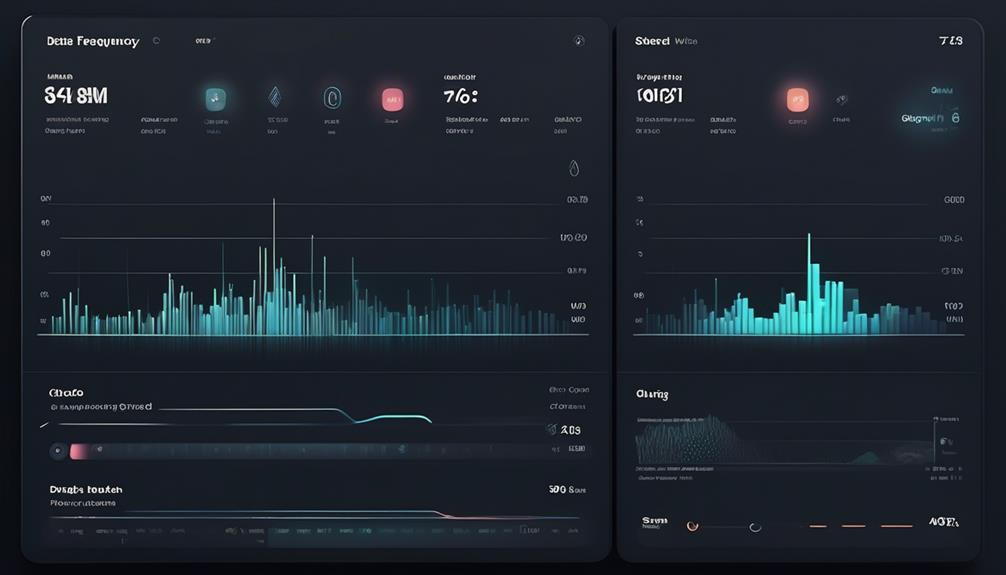Are you ready to delve into the world of Spotify analytics? Our comprehensive guide on understanding the Spotify listener’s journey has everything you need.
Imagine this: your latest track starts gaining traction, and you want to know exactly who’s listening and when. We’ll show you how to set up an artist profile, track listener growth, and even evaluate playlist representation.
Get ready to optimize your Spotify presence and connect with your audience on a whole new level.
Let’s dive in!

Key Takeaways
- Setting up and updating an artist profile is crucial for connecting with your audience and keeping them engaged.
- Tracking and analyzing listener data provides valuable insights to understand audience preferences and behaviors.
- Geographical analysis and targeting allows for targeted marketing campaigns and expansion into untapped markets.
- Playlist evaluation and engagement is important for understanding listener preferences and optimizing playlists for increased engagement.
Setting up an Artist Profile
We’ll show you how to create an engaging artist profile on Spotify. Setting up an artist profile is crucial for targeting demographics and increasing followers on the platform.
To start, choose a profile picture that represents your brand or image effectively. Next, craft a compelling bio that introduces your music and connects with your audience. Be sure to include relevant information such as your genre, influences, and upcoming releases.
Additionally, make use of Spotify’s playlist feature to showcase your favorite tracks and collaborate with other artists. Regularly update your profile with new releases, tour dates, and exclusive content to keep your followers engaged.
By optimizing your artist profile, you can build a strong fan base and increase your chances of success on Spotify.

Now that you have a captivating artist profile, let’s move on to the next step: tracking listener growth.
Tracking Listener Growth
As we track listener growth, we can gain valuable insights into our audience’s preferences and behaviors on Spotify. By analyzing streaming platforms, we can understand the demographics of our listeners and tailor our content accordingly.
Tracking listener demographics allows us to identify trends and patterns, helping us create targeted marketing strategies to reach our desired audience. We can also use this data to discover new opportunities for growth and expansion.
With the ever-evolving nature of the music industry, it’s crucial to stay informed about our listeners and adapt our approach accordingly. By continuously monitoring and analyzing listener growth, we can make informed decisions that will enhance our presence on Spotify and strengthen our connection with our audience.

Identifying Peak Listening Hours
By analyzing listener data, we can pinpoint the peak listening hours when our audience is most active on Spotify. Understanding audience behavior and peak listening trends is crucial for optimizing our content strategy and maximizing engagement. Here are three key insights:
-
Morning Commute: Many listeners tune in during their morning commute, between 7 am and 9 am. This is a great opportunity to capture their attention with uplifting playlists or informative podcasts that set a positive tone for the day.
-
After Work Relaxation: After a long day, listeners tend to unwind and relax with music. The peak hours for this are between 6 pm and 9 pm. This is the perfect time to curate soothing playlists or share calming tracks that help listeners wind down.
-
Late-Night Vibes: A significant portion of our audience enjoys listening to music late at night, between 10 pm and 12 am. This is an ideal time to curate playlists that cater to their introspective moods or share energetic tracks that keep them going during late-night activities.

Understanding these peak listening hours allows us to tailor our content and engage with our audience at the right time, enhancing their overall listening experience.
Monitoring Geographical Listener Distribution
When it comes to mastering the Spotify listener’s journey, one crucial aspect is monitoring the geographical distribution of listeners.
By tracking listener location, we can gain valuable insights into the geographical listening patterns of our audience.
This data allows us to identify regions where our music is most popular, enabling us to target specific locations with tailored marketing campaigns and promotions.

Tracking Listener Location
We monitor the geographical distribution of listeners to track their location on Spotify. This allows us to gain valuable insights into listener behavior and analyze streaming habits. Tracking listener location helps us understand where our audience is located and tailor our content and recommendations accordingly.
Here are three key reasons why tracking listener location is important:
-
Personalized recommendations: By knowing where our listeners are located, we can provide personalized recommendations based on their geographical preferences. This ensures that our users receive music suggestions that are relevant to their local taste and cultural preferences.
-
Targeted marketing: Understanding the geographical distribution of our listeners allows us to create targeted marketing campaigns. By focusing on specific regions, we can customize our promotions to resonate with local audiences and increase engagement.

-
Market expansion: Tracking listener location helps us identify untapped markets and potential growth opportunities. By analyzing streaming habits in different regions, we can make informed decisions on expanding our presence and reaching new audiences.
Analyzing Geographical Listening Patterns
Our comprehensive guide includes valuable insights on analyzing geographical listening patterns to monitor the distribution of Spotify listeners. Understanding listener behavior and regional preferences is essential for maximizing the impact of your music on different audiences. By analyzing geographical listening patterns, you can gain valuable insights into where your music is resonating the most and tailor your promotional strategies accordingly.
Spotify’s data-driven approach allows you to track the location of your listeners and identify regions where your music is gaining traction. This information can help you identify new markets to target and plan tours or promotional campaigns effectively. Additionally, analyzing geographical listening patterns can reveal interesting trends and patterns in listener behavior, such as which genres or artists are popular in specific regions.
Targeting Specific Regions
To effectively target specific regions, we can monitor the geographical distribution of Spotify listeners. By analyzing the data, we can develop targeting strategies that cater to the preferences of listeners in different regions. Here are three key insights that can help guide your regional targeting efforts:

-
Identify popular genres: By analyzing listening patterns in different regions, you can determine which genres are popular in each area. This knowledge can help you curate regional playlists that resonate with local listeners.
-
Understand cultural preferences: Different regions have unique cultural backgrounds and musical tastes. By studying the listening habits of Spotify users in specific areas, you can gain insights into the cultural preferences that influence their music choices. This understanding can inform your regional playlist curation.
-
Engage local influencers: Collaborating with influencers who’ve a strong presence in specific regions can be an effective way to target local listeners. By partnering with influencers who align with your brand and have a substantial following in a particular region, you can increase the visibility of your music and connect with a more targeted audience.
Evaluating Your Playlist Representation
First, let’s take a look at how well our playlists represent our desired music preferences. Playlist curation is a crucial aspect of creating an engaging listening experience on Spotify. To ensure user satisfaction, it’s important to evaluate whether our playlists accurately reflect the music that resonates with our audience.

One way to do this is by analyzing data-driven insights. We can assess the popularity of songs within our playlists, the frequency of user interactions such as likes and saves, and the overall listening time. Additionally, feedback from our listeners plays a vital role in understanding their preferences and making necessary adjustments.
Gauging Listener Engagement
When it comes to gauging listener engagement on Spotify, there are several key points to consider.
First, measuring playlist retention is crucial in understanding how long listeners stay engaged with your playlists. This data can provide insights into whether your playlist is resonating with your target audience.
Additionally, analyzing skip rates can help identify which songs are being skipped and potentially indicate areas for improvement or content optimization.

Lastly, tracking user interactions, such as likes, comments, and shares, can provide valuable feedback on the overall engagement and reception of your playlists.
Measuring Playlist Retention
We often analyze playlist retention to gauge our listeners’ engagement on Spotify. By measuring how long listeners stay engaged with a playlist, we can gain valuable insights into their preferences and behaviors.
Here are three key factors to consider when measuring playlist retention:
-
Playlist Curation: The quality and relevance of the songs in a playlist play a crucial role in retaining listeners. By curating playlists that align with the interests and tastes of our audience, we can increase their engagement and likelihood of staying.

-
User Behavior: Understanding how listeners interact with playlists is essential for measuring retention. Analyzing metrics such as skip rates, repeat listens, and time spent on a playlist can provide valuable insights into user engagement and satisfaction.
-
Playlist Length: The length of a playlist can impact retention rates. Long playlists may lead to listener fatigue, while shorter ones mightn’t offer enough variety. Finding the right balance is key to keeping listeners engaged and coming back for more.
Analyzing Skip Rates
One important metric to consider when gauging listener engagement on Spotify is the skip rates. By conducting skip rate analysis, we can gain valuable insights into listener behavior and their level of engagement with the platform.
Skip rates refer to the frequency at which listeners skip to the next track before a song has finished playing. High skip rates may indicate that listeners aren’t finding the content engaging enough or that they’re actively seeking out specific songs or artists. On the other hand, low skip rates may suggest that listeners are enjoying the content and are more likely to stay engaged.

Understanding listener behavior through skip rate analysis allows us to tailor our content and recommendations to better meet their preferences, ultimately enhancing the overall listening experience.
Moving forward, let’s delve into the next section on tracking user interactions.
Tracking User Interactions
To effectively gauge listener engagement on Spotify, we rely on tracking user interactions throughout their journey on the platform. By closely monitoring user behavior, we can better understand listener habits and optimize the overall user experience.
Here are three key aspects of tracking user interactions:

-
Playback behavior: By analyzing how often listeners skip or replay songs, we can gain insights into their preferences and tailor personalized recommendations accordingly. This data helps us understand what engages listeners and what doesn’t.
-
Playlist creation: Tracking user behavior when creating and editing playlists allows us to understand the curatorial aspect of the Spotify experience. We can identify trends in playlist creation, popular genres, and even discover emerging artists.
-
Social interactions: Monitoring how users engage with social features like sharing, following, and commenting helps us gauge the level of community involvement. This data allows us to enhance social interactions and foster a sense of belonging within the Spotify community.
Quantifying Social Media Resonance
As Spotify users, we can effectively quantify the resonance of social media by analyzing engagement metrics and tracking the reach of our content. Measuring social media impact is crucial in understanding how our audience responds to our music and marketing efforts.

By analyzing metrics such as likes, comments, shares, and click-through rates, we can gauge the level of engagement our content generates. Additionally, analyzing audience sentiment allows us to understand how our music is being received and perceived by our listeners. Sentiment analysis tools can help us determine whether the sentiment is positive, negative, or neutral.
This data-driven approach enables us to make informed decisions about our content strategy, allowing us to create a more intimate and meaningful connection with our audience.
Studying Demographic Data
The demographic data provides valuable insights into the characteristics and preferences of our Spotify listeners. By studying listener demographics, we can gain a deeper understanding of who our audience is and how to better cater to their needs.
Here are three key areas to focus on when analyzing listener engagement:

-
Age and Gender: Understanding the age and gender distribution of our listeners can help us tailor our content and recommendations to specific groups. For example, if we find that a significant portion of our audience is in the 18-24 age range, we can curate playlists that align with their musical tastes.
-
Location: Knowing where our listeners are located allows us to create region-specific playlists and promotions. By analyzing listener engagement from different regions, we can identify trends and preferences that can inform our marketing strategies.
-
Listening Habits: Examining how our listeners engage with our platform, such as their favorite genres, most frequently played artists, and time of day they listen, helps us deliver personalized experiences. By understanding their listening habits, we can recommend relevant content and optimize the user experience.
Studying listener demographics and analyzing listener engagement is crucial for tailoring our offerings and ensuring a personalized and engaging experience for every Spotify user.

Following Popularity Indications
When it comes to following popularity indications on Spotify, it’s crucial for us to embrace popular music and understand its appeal to the masses. By tracking listener preferences, we can gain valuable insights into what resonates with our target audience and tailor our content accordingly.
Additionally, leveraging trending playlists can help us stay ahead of the curve and ensure our music reaches a wider audience.
Embracing Popular Music
We love embracing popular music on Spotify and following the indications of its popularity. It allows us to stay connected to the latest trends and understand the preferences of our listeners.
Here are a few reasons why embracing popular music is important:

-
Embracing new trends: By keeping up with popular music, we can stay ahead of the curve and discover emerging artists and genres before they hit the mainstream. This allows us to curate playlists that are fresh and exciting for our listeners.
-
Understanding listener preferences: Popular music is popular for a reason – it resonates with a wide audience. By analyzing the popularity of certain songs and artists, we can gain insights into what our listeners enjoy and tailor our recommendations accordingly.
-
Building a sense of community: Popular music has the power to bring people together. When we embrace the same songs and artists as our listeners, we create a sense of camaraderie and shared experiences, fostering a deeper connection between us and our audience.
Tracking Listener Preferences
To effectively track listener preferences on Spotify, we need to pay attention to the popularity indications and adapt our content accordingly.

Tracking listener preferences involves evaluating playlist representation, analyzing data, and understanding what resonates with our audience.
By closely monitoring the popularity indications such as the number of streams, likes, and playlist placements, we can gain valuable insights into what songs and genres are most appealing to our listeners.
This data-driven approach allows us to curate playlists that align with our audience’s preferences and keep them engaged.
It’s important to regularly evaluate playlist representation to ensure a diverse and dynamic collection of music that caters to different moods and tastes.

Leveraging Trending Playlists
By actively monitoring and leveraging trending playlists, we can capitalize on the popularity indications and optimize our content strategy on Spotify. This allows us to stay ahead of the curve and connect with our target audience in a more intimate way.
Here are three key ways to leverage trending playlists:
-
Leveraging influencer partnerships: Collaborating with influential individuals in the music industry can give our content a significant boost. By partnering with popular artists or music influencers, we can gain exposure to their large fan base and increase our chances of being featured in trending playlists.
-
Optimizing playlist cover art: Eye-catching visuals are crucial in attracting listeners’ attention. By creating visually appealing and relevant playlist cover art, we can make our playlists more enticing and increase their chances of being included in trending playlists.

-
Staying up-to-date with music trends: Keeping a finger on the pulse of current music trends is essential. By understanding what genres, artists, and songs are currently popular, we can curate playlists that align with listeners’ preferences and increase our chances of being featured in trending playlists.
Evaluating Spotify Royalty Metrics
As avid Spotify users, we often find ourselves evaluating the various royalty metrics to understand the impact of our listening habits on artists.
When it comes to evaluating data accuracy, it’s important to consider the source of the information. Spotify provides artists with detailed reports on their streams, allowing them to accurately assess their earnings. However, it’s worth noting that these reports may not always capture the full picture, especially when it comes to royalty rates.
It’s essential to compare royalty rates across different platforms to get a better understanding of the industry standards. This way, we can ensure that our favorite artists are receiving fair compensation for their work.

Analyzing Listener Retention Rates
We frequently examine the listener retention rates to gain insights into how our favorite artists are engaging and retaining their audience on Spotify. Understanding listener engagement is crucial for artists to build a loyal fan base and increase their popularity on the platform.
Here are some key factors to consider when analyzing listener retention rates:
-
Track retention: Examining how listeners engage with individual tracks can provide valuable insights into which songs resonate the most with the audience. Artists can then focus on creating more content that aligns with listener preferences.
-
Playlist representation: Being featured on popular playlists can significantly impact listener retention rates. Artists should aim to have their music included in relevant playlists to increase exposure and attract new listeners.

-
Listening patterns: Monitoring when listeners tune in and how long they stay engaged can help artists optimize their release schedules and create content that keeps listeners coming back for more.
Optimizing Your Spotify Presence
When optimizing our Spotify presence, we focus on maximizing our visibility and engagement with listeners. To effectively target our audience, we need to understand their preferences and behaviors.
Utilizing data-driven insights, we can tailor our content to resonate with our listeners and increase their engagement. Analyzing listener data such as demographics, listening habits, and preferences can help us identify the optimal content to create.
Additionally, we can utilize Spotify’s playlist curators and influencers to amplify our reach and connect with our target audience.

Optimizing our content involves creating high-quality tracks, compelling cover art, and engaging descriptions that captivate listeners.
Conclusion
In conclusion, mastering the Spotify listener’s journey requires a combination of data-driven insights and attention to detail. By setting up an artist profile, tracking listener growth, and analyzing metrics such as peak listening hours and geographical distribution, you can optimize your Spotify presence.
Remember, ‘the early bird catches the worm’ when it comes to identifying popularity indications and evaluating playlist representation. With careful evaluation and optimization, you can navigate the Spotify landscape and reach a wider audience for your music.










